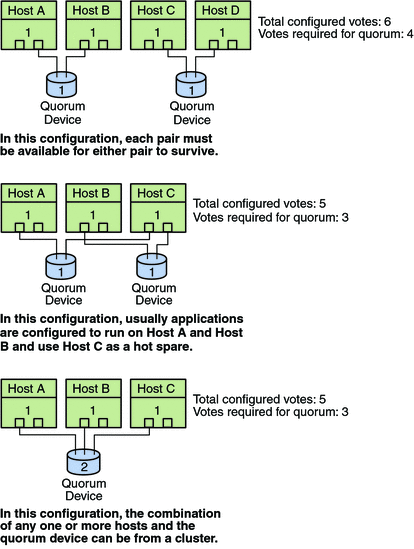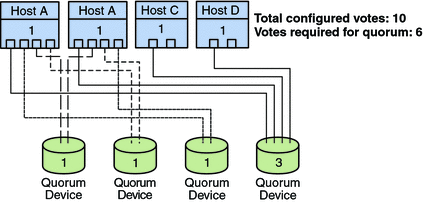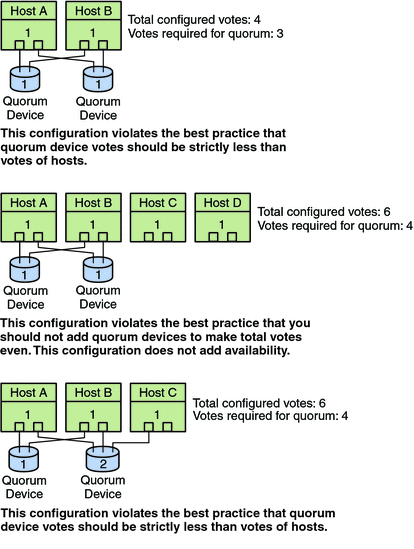Quorum and Quorum Devices
This section contains the following topics:
Note –
For a list of the specific devices that Sun Cluster software supports as quorum devices, contact your Sun service provider.
Because cluster nodes share data and resources, a cluster must never split into separate partitions that are active at the same time because multiple active partitions might cause data corruption. The Cluster Membership Monitor (CMM) and quorum algorithm guarantee that, at most, one instance of the same cluster is operational at any time, even if the cluster interconnect is partitioned.
For an introduction to quorum and CMM, see Cluster Membership in Sun Cluster Overview for Solaris OS.
Two types of problems arise from cluster partitions:
Split brain occurs when the cluster interconnect between nodes is lost and the cluster becomes partitioned into subclusters. Each partition “believes” that it is the only partition because the nodes in one partition cannot communicate with the node or nodes in the other partition.
Amnesia occurs when the cluster restarts after a shutdown with cluster configuration data that is older than the data was at the time of the shutdown. This problem can occur when you start the cluster on a node that was not in the last functioning cluster partition.
Sun Cluster software avoids split brain and amnesia by:
-
Assigning each node one vote
-
Mandating a majority of votes for an operational cluster
A partition with the majority of votes gains quorum and is allowed to operate. This majority vote mechanism prevents split brain and amnesia when more than two nodes are configured in a cluster. However, counting node votes alone is not sufficient when more than two nodes are configured in a cluster. In a two-host cluster, a majority is two. If such a two-host cluster becomes partitioned, an external vote is needed for either partition to gain quorum. This external vote is provided by a quorum device.
About Quorum Vote Counts
Use the clquorum show command to determine the following information:
-
Total configured votes
-
Current present votes
-
Votes required for quorum
See the cluster(1CL) man page.
Both nodes and quorum devices contribute votes to the cluster to form quorum.
A node contributes votes depending on the node's state:
-
A node has a vote count of one when it boots and becomes a cluster member.
-
A node has a vote count of zero when the node is being installed.
-
A node has a vote count of zero when a system administrator places the node into maintenance state.
Quorum devices contribute votes that are based on the number of votes that are connected to the device. When you configure a quorum device, Sun Cluster software assigns the quorum device a vote count of N-1 where N is the number of connected votes to the quorum device. For example, a quorum device that is connected to two nodes with nonzero vote counts has a quorum count of one (two minus one).
A quorum device contributes votes if one of the following two conditions are true:
-
At least one of the nodes to which the quorum device is currently attached is a cluster member.
-
At least one of the hosts to which the quorum device is currently attached is booting, and that host was a member of the last cluster partition to own the quorum device.
You configure quorum devices during the cluster installation, or afterwards, by using the procedures that are described in Chapter 6, Administering Quorum, in Sun Cluster System Administration Guide for Solaris OS.
About Quorum Configurations
The following list contains facts about quorum configurations:
-
Quorum devices can contain user data.
-
In an N+1 configuration where N quorum devices are each connected to one of the 1 through N Solaris hosts and the N+1 Solaris host, the cluster survives the death of either all 1 through N Solaris hosts or any of the N/2 Solaris hosts. This availability assumes that the quorum device is functioning correctly.
-
In an N-host configuration where a single quorum device connects to all hosts, the cluster can survive the death of any of the N-1 hosts. This availability assumes that the quorum device is functioning correctly.
-
In an N-host configuration where a single quorum device connects to all hosts, the cluster can survive the failure of the quorum device if all cluster hosts are available.
For examples of quorum configurations to avoid, see Bad Quorum Configurations. For examples of recommended quorum configurations, see Recommended Quorum Configurations.
Adhering to Quorum Device Requirements
Ensure that Sun Cluster software supports your specific device as a quorum device. If you ignore this requirement, you might compromise your cluster's availability.
Note –
For a list of the specific devices that Sun Cluster software supports as quorum devices, contact your Sun service provider.
Sun Cluster software supports the following types of quorum devices:
-
Multihosted shared disks that support SCSI-3 PGR reservations.
-
Dual-hosted shared disks that support SCSI-2 reservations.
-
A Network-Attached Storage (NAS) device from Sun Microsystems, Incorporated or from Network Appliance, Incorporated.
-
A quorum server process that runs on the quorum server machine.
-
Any shared disk, provided that you have turned off fencing for this disk, and are therefore using software quorum. Software quorum is a protocol developed by Sun Microsystems that emulates a form of SCSI Persistent Group Reservations (PGR).
 Caution –
Caution – If you are using disks that do not support SCSI, such as Serial Advanced Technology Attachment (SATA) disks, turn off fencing.
Note –
You cannot use a replicated device as a quorum device.
In a two–host configuration, you must configure at least one quorum device to ensure that a single host can continue if the other host fails. See Figure 3–2.
For examples of quorum configurations to avoid, see Bad Quorum Configurations. For examples of recommended quorum configurations, see Recommended Quorum Configurations.
Adhering to Quorum Device Best Practices
Use the following information to evaluate the best quorum configuration for your topology:
-
Do you have a device that is capable of being connected to all Solaris hosts of the cluster?
-
If yes, configure that device as your one quorum device. You do not need to configure another quorum device because your configuration is the most optimal configuration.
 Caution –
Caution – If you ignore this requirement and add another quorum device, the additional quorum device reduces your cluster's availability.
-
If no, configure your dual-ported device or devices.
-
-
Ensure that the total number of votes contributed by quorum devices is strictly less than the total number of votes contributed by nodes. Otherwise, your nodes cannot form a cluster if all disks are unavailable, even if all nodes are functioning.
Note –In particular environments, you might want to reduce overall cluster availability to meet your needs. In these situations, you can ignore this best practice. However, not adhering to this best practice decreases overall availability. For example, in the configuration that is outlined in Atypical Quorum Configurations the cluster is less available: the quorum votes exceed the node votes. In a cluster, if access to the shared storage between Host A and Host B is lost, the entire cluster fails.
See Atypical Quorum Configurations for the exception to this best practice.
-
Specify a quorum device between every pair of hosts that shares access to a storage device. This quorum configuration speeds the fencing process. See Quorum in Greater Than Two–Host Configurations.
-
In general, if the addition of a quorum device makes the total cluster vote even, the total cluster availability decreases.
-
Quorum devices slightly slow reconfigurations after a node joins or a node dies. Therefore, do not add more quorum devices than are necessary.
For examples of quorum configurations to avoid, see Bad Quorum Configurations. For examples of recommended quorum configurations, see Recommended Quorum Configurations.
Recommended Quorum Configurations
This section shows examples of quorum configurations that are recommended. For examples of quorum configurations you should avoid, see Bad Quorum Configurations.
Quorum in Two–Host Configurations
Two quorum votes are required for a two-host cluster to form. These two votes can derive from the two cluster hosts, or from just one host and a quorum device.
Figure 3–2 Two–Host Configuration

Quorum in Greater Than Two–Host Configurations
Quorum devices are not required when a cluster includes more than two hosts, as the cluster survives failures of a single host without a quorum device. However, under these conditions, you cannot start the cluster without a majority of hosts in the cluster.
You can add a quorum device to a cluster that includes more than two hosts. A partition can survive as a cluster when that partition has a majority of quorum votes, including the votes of the hosts and the quorum devices. Consequently, when adding a quorum device, consider the possible host and quorum device failures when choosing whether and where to configure quorum devices.

Atypical Quorum Configurations
Figure 3–3 assumes you are running mission-critical applications (Oracle database, for example) on Host A and Host B. If Host A and Host B are unavailable and cannot access shared data, you might want the entire cluster to be down. Otherwise, this configuration is suboptimal because it does not provide high availability.
For information about the best practice to which this exception relates, see Adhering to Quorum Device Best Practices.
Figure 3–3 Atypical Configuration

Bad Quorum Configurations
This section shows examples of quorum configurations you should avoid. For examples of recommended quorum configurations, see Recommended Quorum Configurations.

- © 2010, Oracle Corporation and/or its affiliates
